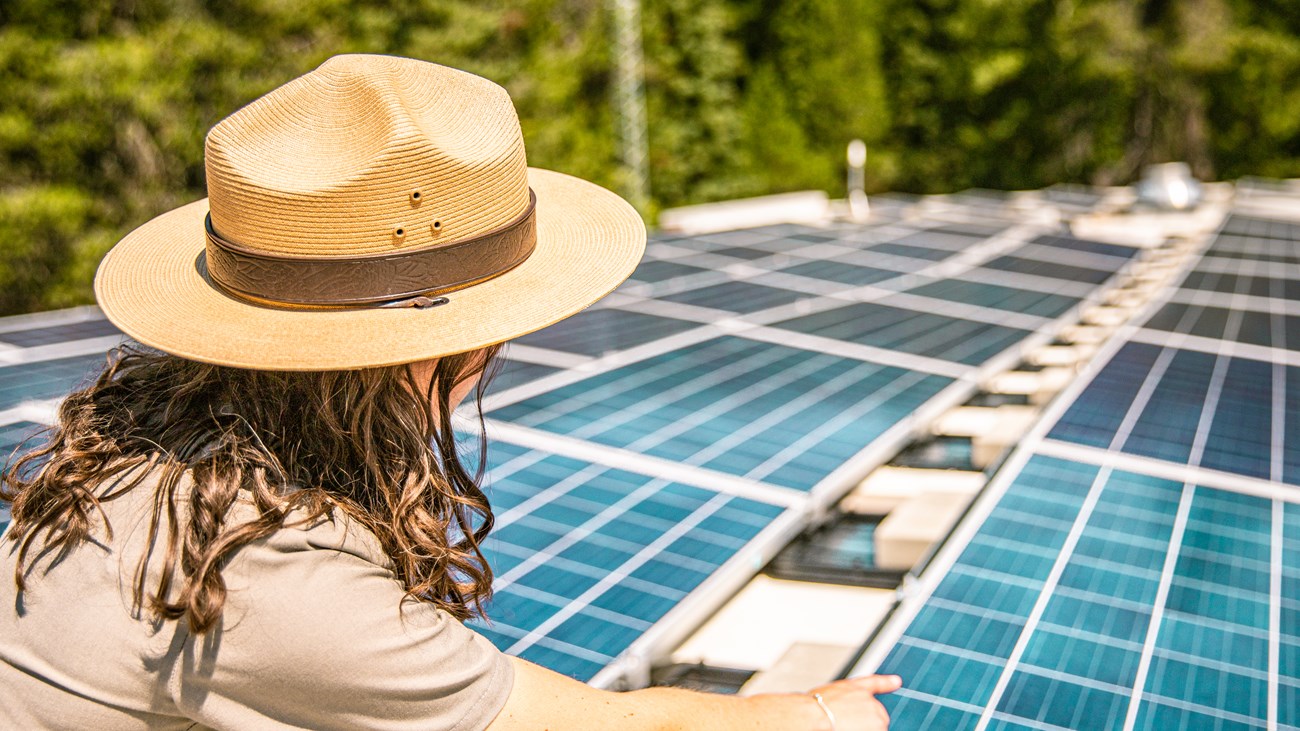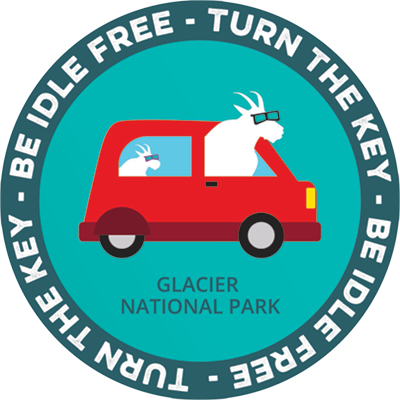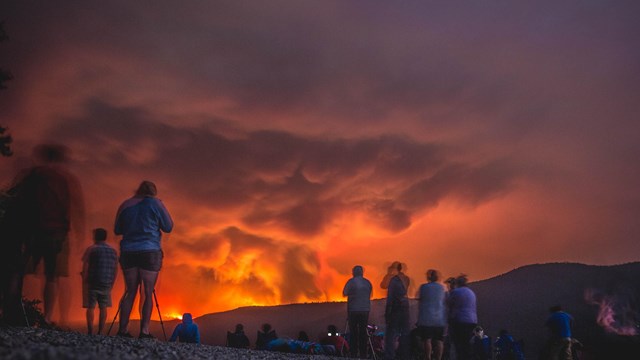
Sustainability is a commitment to the future.Reducing your personal carbon footprint is a great way to take part in that commitment. However, collective action taken in our parks and communities is necessary to achieve sustainability into the future. And ultimately, reducing greenhouse gas emissions will require global effort. Luckily, many of the solutions already exist, and require less sacrifice from individuals than you might expect. Improving how we dispose of refrigerant chemicals is one of the most important solutions to climate change. Coolants commonly used in refrigerators and air conditioners, called hydrofluorocarbons or HFCs, trap heat in the atmosphere 1,000 to 9,000 times better than carbon dioxide. Avoiding leaks, switching to alternatives, and properly disposing of old refrigerants is one of the single biggest solutions to climate change. Food waste accounts for about 8 percent of global emissions. In the United States, wasted food forms the largest component of trash. According to the United States Department of Agriculture, 30 to 40 percent of the food supply ends up wasted in landfills where it generates greenhouse gases as it decomposes. This waste can occur at any stage of the supply chain–during production, processing, retailing, or consumption–so implementing this solution has less to do with individuals finishing their dinner, and more to do with systemic adjustments.
Different kinds of foods produce different amounts of greenhouse gases. About one-fifth of global emissions come from the production of meat and dairy products. Producing meat and dairy requires land clearing, fertilizers, and burping cattle, all of which create greenhouse gases. Adjusting global food systems to slim down meat and dairy consumption while making plant rich diets easier and cheaper could make a big difference in solving climate change. Another way to reduce waste is through recycling and composting. These solutions may have a small impact when compared to managing refrigerants, reducing food waste, and adopting plant-rich diets, but could still play an important role. Recycling can reduce emissions because making new products from recycled materials often saves energy. Instead of sending waste to the landfill, where it decays and emits greenhouse gases, we can compost lots of materials into stable soil carbon. Learn more about Glacier National Park's recycling efforts here. Cars, furnaces, stoves, and water heaters are all commonly powered by fuels that release greenhouse gases. To fight climate change, these appliances will need to be replaced with those that run on renewable electricity. Overall, these upgrades will actually reduce the total energy needed to power our lives because electricity is so much more efficient than fossil fuels. However, while we’ll need less energy overall, we will need to dramatically increase renewable electricity production.
One way to increase renewable electricity production is with wind turbines and solar panels. Changing electricity production away from sources that release greenhouse gases is an essential part of responding to climate change. Since the sun shines for free and the wind blows without payment, turbines and solar panels will soon be the least expensive ways to generate electricity. This means that responding to climate change can also save money. Fossil fuel-powered vehicles have taken us a long way, but to confront climate change, vehicles will need to be powered by renewable electricity. This transition has many side benefits as well. Cars will be quieter but also zippier. Air quality and noise pollution will both be improved. Lastly, electric vehicles, having fewer moving parts, require less maintenance.
Switching from energy-wasting bulbs that generate excess heat to long lasting LED bulbs is one easy climate change solution. LEDs use 90 percent less energy than incandescent bulbs for the same amount of light, and unlike compact fluorescent bulbs, they don’t contain toxic mercury. They’re also much longer-lasting.
Introduction Griffith, Saul. “Rewiring America: A Field Manual for the Climate Fight.” Rewiring America, July 2020. https://www.rewiringamerica.org/handbook. Pp. i. “We can have pretty much all of the complexity and variety of the American dream, with the same– sized homes and vehicles — and we’ll need less than half the energy we currently use. This is a success story that casts aside trying to “efficiency” or “deprive” our way to zero emissions.” Griffith, Saul. Electrify: An Optimist’s Playbook for Our Clean Energy Future. Cambridge, Massachusetts: The MIT Press, 2021. https://mitpress.mit.edu/books/electrify Pp. xi. “Solving climate change should taste at least as good as carrots, at best ice cream, but it should not be painful.” Pp. xii. “Our country faces a challenge of transformation, not of deprivation.” Pp. 6. “...personal carbon footprint is largely determined by a handful of infrequent decisions,” Mann, Michael E. The New Climate War: The Fight to Take Back Our Planet. First edition. New York: PublicAffairs, 2021. Pp. 3. “Personal actions, from going vegan to avoiding flying, are increasingly touted as the primary solution to the climate crisis. Though these actions are worth taking, a fixation on voluntary action alone takes the pressure off of the push for governmental policies to hold corporate polluters accountable.” Hagmann, David, Emily H. Ho, and George Loewenstein. “Nudging out Support for a Carbon Tax.” Nature Climate Change 9, no. 6 (June 2019): 484–89. https://doi.org/10.1038/s41558-019-0474-0. Pp. 484. “The most effective policies for reducing carbon emissions rely on traditional heavy-handed government interventions, such as excise taxes, fuel efficiency standards for cars and subsidies for adopting renewable energy sources.” “Across six experiments, respondents were asked to decide whether or not to implement a carbon tax policy or a green nudge policy. We find that exposing survey respondents to the potential for a green energy nudge diminishes their support for a carbon tax (Studies 1A and 2B).” Pp. 488. “An ideal world would have a place for both nudges and more heavy-handed interventions to combat climate change. However, our results indicate that an effort to deploy both can backfire by reducing the likelihood that the most effective policies will be implemented.”
Refrigerant Management Hawken, Paul, ed. Drawdown: The Most Comprehensive Plan Ever Proposed to Reverse Global Warming, 2017. https://drawdown.org/solutions/refrigerant-management “Substantial emissions reductions could be achieved through the adoption of practices to (1) avoid leaks from refrigerants and (2) destroy refrigerants at end of life, both after the adoption of alternatives to HFC refrigerants. Over thirty years, an increase of over 79% percent of refrigerants that may be released can be contained, avoiding emissions equivalent to 57.8 gigatons of carbon dioxide. HFCs... have 1,000 to 9,000 times greater capacity to warm the atmosphere than carbon dioxide. Substitutes are already on the market, including natural refrigerants such as propane and ammonium. Because 90 percent of refrigerant emissions happen at end of life, effective disposal of those currently in circulation is essential. After being carefully removed and stored, refrigerants can be purified for reuse or transformed into other chemicals that do not cause warming.” Food Waste National Park Service. (2019) “Food Waste - Part 1.” NPS Web Article https://www.nps.gov/articles/foodwaste.htm Pp. 1. “Wasted food is the largest component of trash in the United States. Food waste or food loss is food that is discarded or not eaten. Food loss can occur at any stage of the supply chain – during production, processing, retailing, or consumption. It is any loss of food post-harvest, regardless of the cause. While mold and pests that contaminate food result in food being inedible; plate waste is wasted edible food going unconsumed, or food that is discarded due to undesirable color or blemishes. According to the United Stated Department of Agriculture (USDA), 30-40% of the food supply becomes food waste. In 2010, the U.S. Environmental Protection Agency (EPA) estimated that food waste accounted for nearly 14% of total solid waste in the United States, before recycling. Less than three percent of this food waste was recovered and recycled. After recycling, food waste accounted for about 21% of the remaining total solid waste, the highest of any other category of waste. Unfortunately, food waste ends up in landfills, and generates methane gas as it decomposes. Methane gas is more powerful in accelerating global warming than any other gas, including carbon dioxide.” Hawken, Paul, ed. Drawdown: The Most Comprehensive Plan Ever Proposed to Reverse Global Warming, 2017. https://drawdown.org/solutions/reduced-food-waste “The food we waste is responsible for roughly 8 percent of global emissions.” Plant-Rich Diets Hawken, Paul, ed. Drawdown: The Most Comprehensive Plan Ever Proposed to Reverse Global Warming, 2017. https://drawdown.org/solutions/plant-rich-diets “Project Drawdown defines a plant-rich diet as the individual dietary choice: to 1) maintain a 2250 calorie per day nutritional regime; 2) meet daily protein requirements while decreasing meat consumption in favor of plant-based food items; and 3) purchase locally produced food when available. This solution replaces projected regional dietary trends. Using country-level data from the Food and Agriculture Organization of the United Nations, we estimate the growth in global food consumption by 2050, assuming that lower-income countries will consume more food overall and higher quantities of meat as economies grow. If 50-75 percent of the world’s population restricts their diet to a healthy average 2,250 calories per day and reduces meat consumption overall, we estimate at least 43-68 gigatons of emissions could be avoided from dietary change alone. If avoided deforestation from land use change is included, an additional 21.8-23.5 gigatons of emissions could be avoided, making healthy, plant-rich diets one of the most impactful solutions at a total of 64.8-91.5 gigatons avoided.” Recycling Hawken, Paul, ed. Drawdown: The Most Comprehensive Plan Ever Proposed to Reverse Global Warming, 2017. https://drawdown.org/solutions/recycling “With about 50 percent of recycled materials coming from households and rest from industry, if the average worldwide recycling rate increases to 65-68 percent of total recyclable waste, household recycling could avoid 5.5-6.0 gigatons of carbon dioxide emissions by 2050. Recycling can reduce emissions because producing new products from recovered materials often saves energy. Forging recycled aluminum products, for example, uses 95 percent less energy than creating them from virgin materials. At least half of waste is industrial and commercial.” Composting Hawken, Paul, ed. Drawdown: The Most Comprehensive Plan Ever Proposed to Reverse Global Warming, 2017. https://drawdown.org/solutions/composting “In 2015, an estimated 38 percent of food waste was composted in the United States; 57 percent was composted in the European Union. If all lower-income countries reached the U.S. rate and all higher-income countries achieved the E.U. rate, composting could avoid methane emissions from landfills equivalent to 2.1-3.1 gigatons of carbon dioxide by 2050. Nearly half of the solid waste produced globally is organic or biodegradable. Much of it ends up in landfills; there, it decomposes in the absence of oxygen and produces the greenhouse gas methane, which is up to 34 times more powerful than carbon dioxide over a century. While many landfills have some form of methane management, it is far more effective to divert organic waste to composting. Composting ranges in scale from backyard bins to industrial operations. The basic process is the same: ensuring sufficient moisture, air, and heat for soil microbes (bacteria, protozoa, and fungi) to feast on organic material. Rather than generating methane, the composting process converts organic material into stable soil carbon, while retaining water and nutrients of the original waste matter. The result is carbon sequestration as well as production of a valuable fertilizer. Copenhagen, Denmark, has not sent organic waste to landfill in more than twenty-five years, reaping compost’s win-win-win of cost savings, fertilizer production, and reduced emissions.” Electrification Griffith, Saul. “Rewiring America: A Field Manual for the Climate Fight.” Rewiring America, July 2020. https://www.rewiringamerica.org/handbook. Pp. i. “We can have pretty much all of the complexity and variety of the American dream, with the same– sized homes and vehicles — and we’ll need less than half the energy we currently use. This is a success story that casts aside trying to “efficiency” or “deprive” our way to zero emissions.” Pp. 1. “The technical path to decarbonization is simply this: we must electrify (nearly) everything. We need a near 100% adoption rate of decarbonized solutions. It is the big purchases that count far more than the little ones. Your next car needs to be electric, your next furnace a heat pump, and you need solar on your roof. This is your personal zero– carbon infrastructure.” Pp. 35. “When we replace everything in our lives with electricity, cars will be zippier, the air in our cities, suburbs, and homes will be cleaner, our appliances will be better, the streets will be quieter, and our carbon–consciences will be clear. We have the technology we need, today, to solve climate change. And when we electrify everything, as we’ll soon show, we will eliminate more than half the energy we think we need!” Pp. 37. “In a power plant today, fossil fuels are burned to generate heat, which is used to make steam, which is used to spin a turbine, which is used to create electricity. Physics tells us that using heat to generate electricity is subject to inescapable limits on efficiency. Those limits are set by the laws of thermodynamics, which dictate that a machine that converts heat to electricity will lose half or more of the energy involved in doing the conversion. Carbon–free, non–thermal sources like solar and wind — while also subject to the laws of physics — don’t involve so many conversions from one type of energy to another.” Pp. 42. “When we add up all of those savings, we find we only need 40% of the primary energy we use today. Well, that is pretty remarkable. We can cut the problem down by more than half with no efficiency measures other than electrification. No thermostats were turned down, no vehicles were downsized, no homes were shrunk.” Pp. 44. “To electrify everything, we’ll need more than three times the amount of electricity that we currently produce. Today, the U.S. grid delivers, on average, 450 GW of electricity. If we electrify nearly everything as we described in the last chapter, we’ll need somewhere between 1500 GW and 1800 GW.” Wind & Solar Hawken, Paul, ed. Drawdown: The Most Comprehensive Plan Ever Proposed to Reverse Global Warming, 2017. https://drawdown.org/solutions/onshore-wind-turbines “An increase in onshore wind turbines from 4.4 percent of world electricity generation to a wide range from 19.6-26.9 percent by 2050 could reduce emissions by 47-147 gigatons of greenhouse gases. In many locales, wind is either competitive with or less expensive than coal-generated electricity—and it has no fuel costs and no pollution. Ongoing cost reduction will soon make wind energy the least expensive source of electricity, perhaps within a decade. Onshore wind farms have small footprints, typically using no more than 1 percent of the land they sit on, so grazing, farming, recreation, or conservation can happen simultaneously with power generation. What’s more, it takes one year or less to build a wind farm—quickly producing energy and a return on investment.” Hawken, Paul, ed. Drawdown: The Most Comprehensive Plan Ever Proposed to Reverse Global Warming, 2017. https://drawdown.org/solutions/utility-scale-solar-photovoltaics “Our scenarios project that by 2050, this solution could represent 20-25% of the electricity generation mix, with generation levels of 9,353-17,740 TWh. We assume an implementation cost of $1,733 per kilowatt and a learning rate of 21 percent. This results in cumulative first costs of $3.4-5 trillion, but with a huge amount of lifetime operational savings of $13-26 trillion – one of the financial benefits of producing electricity without fuel. The significant increase of the solution use could avoid 44-119 gigatons of greenhouse gases emissions depending on the climate mitigation ambition and electrification of demand side sectors. The sun provides a virtually unlimited, clean, and free fuel at a price that never changes. They operate at a utility scale like conventional power plants in the amount of electricity they produce, but dramatically differ in their emissions. Solar farms can be found in deserts, on military bases, atop closed landfills, and even floating on reservoirs, deploying silicon panels to harvest the photons streaming to earth. In many parts of the world, solar PV is now cost competitive with or less costly than conventional power generation.” Hawken, Paul, ed. Drawdown: The Most Comprehensive Plan Ever Proposed to Reverse Global Warming, 2017. https://drawdown.org/solutions/distributed-solar-photovoltaics Our analysis assumes that distributed solar photovoltaics can grow from 180 TWh of current electricity generation globally to a wide range between 6,235-10,100 TWh by 2050. This uncertainty of generation potential is linked to the different expectations of energy technologies on different future climate mitigation pathways intertwined with the role of electricity on the energy systems. That growth can avoid 27-69 gigatons of greenhouse gases emissions. With implementation costs reducing by the day, over the lifetime of distributed photovoltaic technologies, it could save $7.9-13.5 trillion in associated operation and maintenance and fuel costs. Small-scale solar systems, typically sited on rooftops, accounted for roughly 30 percent of PV capacity installed worldwide in 2015.” National Park Service. (2016) “Onshore Wind Energy.” NPS Web Subject https://www.nps.gov/subjects/renewableenergy/onshorewind.htm “Onshore wind turbines capture energy from the wind and produce electricity using long, rotating blades that drive a generator located at the top of the tower behind the blades. The best wind resources are located in areas that receive strong, sustained wind speeds equivalent to wind power class 3 or above and 50 to 80 meters above the ground. While there are some concerns with potential habitat loss, land conversion, transmission infrastructure, and artificial light, the key impacts of onshore wind turbines include noise, turbine strikes, and visual impacts.” Electric Cars Hawken, Paul, ed. Drawdown: The Most Comprehensive Plan Ever Proposed to Reverse Global Warming, 2017. https://drawdown.org/solutions/electric-cars “If electric car ownership rises to 16-23 percent of total passenger km at a first cost of $4.5-5.8 trillion, by 2050, 11.9-15.7 gigatons of carbon dioxide from fuel combustion could be avoided as well as $15.3-21.8 trillion in fuel costs. Our analysis accounts for emissions from electricity generation and higher emissions of producing electric cars compared to internal-combustion cars. Compared to gasoline-powered vehicles, emissions drop by 50 percent if an EV’s power comes off the conventional grid. If powered by solar energy, carbon dioxide emissions fall by 95 percent. The “fuel” for electric cars is cheaper too. EVs… have fewer moving parts, and require little maintenance and no fossil fuels. Typical today is a range of 80 to 90 miles, long enough for most daily travel.” LED Lighting Hawken, Paul, ed. Drawdown: The Most Comprehensive Plan Ever Proposed to Reverse Global Warming, 2017. https://drawdown.org/solutions/led-lighting “As LEDs replace less-efficient lighting, 10.2-10.8 gigatons of carbon dioxide emissions could be avoided in residences and 5.9-6.7 gigatons in commercial buildings. [LEDs] use 90 percent less energy than incandescent bulbs for the same amount of light, and half as much as compact fluorescents, without toxic mercury. By transferring most of their energy use into creating light—rather than heat, like older technologies—LEDs reduce electricity consumption and air-conditioning loads. LED streetlights can save up to 70 percent of energy and significantly reduce maintenance costs. The question about LEDs is not whether they will become the standard in lighting fixtures; it’s when. Virtually any bulb currently in use can be replaced by LEDs.” Glacier National Park, Foundation Document, Foundation Document (Montana: National Park Service, U.S. Department of the Interior, October 2016), https://www.nps.gov/glac/learn/management/upload/GLAC_FD_SP.pdf. Pp. 5. "Glacier is one of the most ecologically intact landscapes remaining in the temperate regions of the world... Because of the melting glaciers and the intact ecological processes, Glacier offers an outstanding opportunity for both research and adaptive responses to the impacts of climate change on a large landscape." Pp. 15. "Continue improving park sustainability, reduction of greenhouse gas emissions, and environmental leadership through the park’s Climate Friendly Parks Program and Environmental Management Systems (Director’s Order 13A). Continued understanding of observed and projected climate change through monitoring of (or access to) weather parameters (precipitation, temperature) and impacts to the landscape, and assessment of projected climate futures (models) for the region." 
Glacier National Park’s goal is to be a leader in understanding, communicating, and responding to climate change.Glacier National Park has already begun an effort to reduce its contribution to a warming climate. Solar arrays and hydropower help provide electricity throughout the park. Improvements to the recycling program are being made. More efficient LEDs are replacing energy-wasting light bulbs. Glacier’s employees can reduce their own carbon emissions by riding the employee shuttle or biking to work. A few specifics are listed below.

Climate Change
Glacier National Park is warming at nearly two times the global average and the impacts are already being felt by park visitors. 
Conservation at Home
Help conserve our parks and protected areas by taking action at home! 
Glacier Repeat Photography
The trend of retreat, apparent here at Glacier National Park, is also seen around the world. 
Overview of the Park's Glaciers
Here are the most frequently asked questions about the park's glaciers. |
Last updated: December 20, 2023
